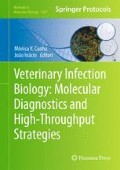Abstract
High-resolution melting (HRM) is a post-PCR technique that determines with high precision the melt profile of PCR products using a new generation of double-stranded DNA-binding dyes and accurate fluorescence data acquisition over small temperature increments. The method can be used to interrogate small sets of single-nucleotide polymorphisms (SNPs). Here, we describe a simple and cost-effective HRM-based method for the screening of 14 phylogenetically informative SNPs within the genome of Bacillus anthracis that subtype the species into 13 major sublineages or subgroups. Fourteen monoplex and seven duplex SNP-discrimination assays have been designed. We detail the parameters most important for the successful application of HRM for B. anthracis genotyping.
Access this chapter
Tax calculation will be finalised at checkout
Purchases are for personal use only
References
Turnbull PC (2002) Anthrax history, disease and ecology. In: Koehler TM (ed) Anthrax, vol 271, Springer-Verlag. Berlin, Germany, pp 1–19
Hugh-Jones M (1999) 1996-97 Global Anthrax Report. J Appl Microbiol 87:189–191
Fasanella A, Galante D, Garofolo G et al (2010) Anthrax undervalued zoonosis. Vet Microbiol 140:318–331
Derzelle S, Thierry S (2013) Genetic Diversity of Bacillus anthracis in Europe: Genotyping Methods in Forensic and Epidemiologic Investigations. Biosecur Bioterror 11:S166–S176
Keim P, Gruendike JM, Klevytska AM et al (2009) The genome and variation of Bacillus anthracis. Mol Aspects Med 30:397–405
Keim P, Price LB, Klevytska AM et al (2000) Multiple-locus variable-number tandem repeat analysis reveals genetic relationships within Bacillus anthracis. J Bacteriol 182:2928–2936
Pearson T, Busch JD, Ravel J et al (2004) Phylogenetic discovery bias in Bacillus anthracis using single-nucleotide polymorphisms from whole-genome sequencing. Proc Natl Acad Sci U S A 101:13536–13541
Van Ert MN, Easterday WR, Huynh LY et al (2007) Global genetic population structure of Bacillus anthracis. PLoS One 2:e461
Marston CK, Allen CA, Beaudry J et al (2011) Molecular epidemiology of anthrax cases associated with recreational use of animal hides and yarn in the United States. PLoS One 6:e28274
Erali M, Voelkerding KV, Wittwer CT (2008) High resolution melting applications for clinical laboratory medicine. Exp Mol Pathol 85:50–58
Hurtle W, Bode E, Kulesh DA et al (2004) Detection of the Bacillus anthracis gyrA gene by using a minor groove binder probe. J Clin Microbiol 42:179–185
Easterday WR, Van Ert MN, Simonson TS et al (2005) Use of single nucleotide polymorphisms in the plcR gene for specific identification of Bacillus anthracis. J Clin Microbiol 43:1995–1997
Satterfield BC, Kulesh DA, Norwood DA et al (2007) Tentacle Probes: differentiation of difficult single-nucleotide polymorphisms and deletions by presence or absence of a signal in real-time PCR. Clin Chem 53: 2042–2050
Easterday WR, Van Ert MN, Zanecki S et al (2005) Specific detection of Bacillus anthracis using a TaqMan mismatch amplification mutation assay. Biotechniques 38:731–735
Birdsell DN, Pearson T, Price EP et al (2012) Melt analysis of mismatch amplification mutation assays (Melt-MAMA): a functional study of a cost-effective SNP genotyping assay in bacterial models. PLoS One 7:e32866
Price EP, Matthews MA, Beaudry JA et al (2010) Cost-effective interrogation of single nucleotide polymorphisms using the mismatch amplification mutation assay and capillary electrophoresis. Electrophoresis 31:3881–3888
Krypuy M, Newnham GM, Thomas DM et al (2006) High resolution melting analysis for the rapid and sensitive detection of mutations in clinical samples: KRAS codon 12 and 13 mutations in non-small cell lung cancer. BMC Cancer 6:295
Author information
Authors and Affiliations
Corresponding author
Editor information
Editors and Affiliations
Rights and permissions
Copyright information
© 2015 Springer Science+Business Media New York
About this protocol
Cite this protocol
Derzelle, S. (2015). Single-Nucleotide Polymorphism Discrimination Using High-Resolution Melting Analysis for the Genotyping of Bacillus anthracis . In: Cunha, M., Inácio, J. (eds) Veterinary Infection Biology: Molecular Diagnostics and High-Throughput Strategies. Methods in Molecular Biology, vol 1247. Humana Press, New York, NY. https://doi.org/10.1007/978-1-4939-2004-4_26
Download citation
DOI: https://doi.org/10.1007/978-1-4939-2004-4_26
Published:
Publisher Name: Humana Press, New York, NY
Print ISBN: 978-1-4939-2003-7
Online ISBN: 978-1-4939-2004-4
eBook Packages: Springer Protocols

